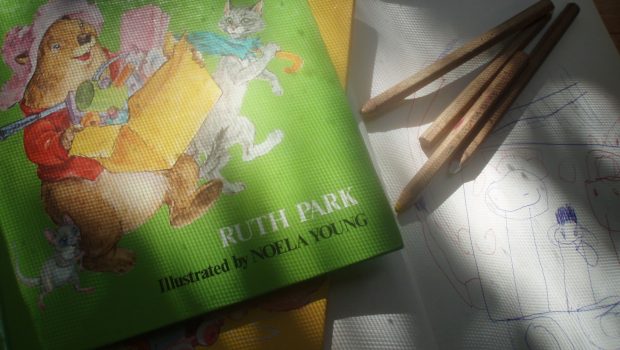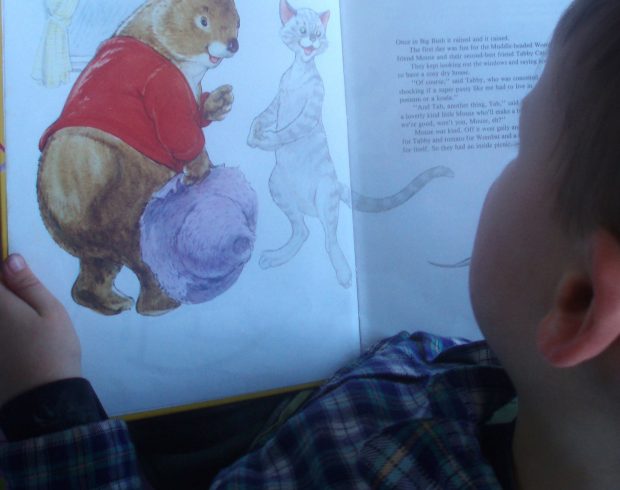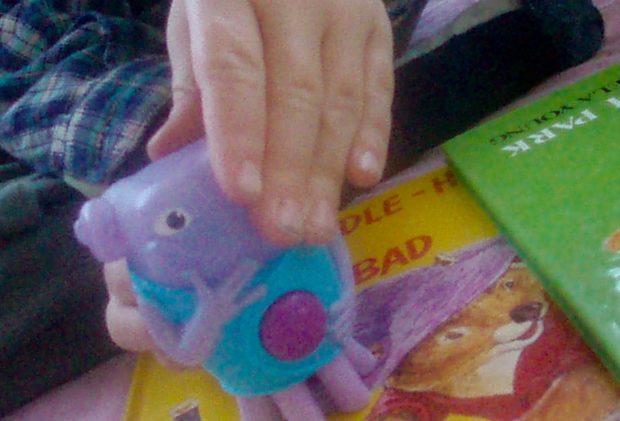Reading Secondhand: Ruth Park at St Vincent de Paul
by Ali Jane Smith
I am a keen, but not obsessive, op shopper. I love bric-a-brac. A novelty biscuit tin, the toys from McDonalds’ Happy Meals, a jigsaw puzzle, cake forks, a milk jug. Tupperware! I’m wary of the books, unless I am in the shop where my neighbour, Dorothy-over-the-road, volunteers. It has the best organised, and tidiest, book section of any op shop I’ve ever been to, better than many for-profit secondhand bookshops. There’s always something worth buying, and it is great for kid’s books. I’ve written elsewhere about a really wonderful book that Dorothy found for me at her shop.
There used to be a St Vincent de Paul conveniently located about halfway home from my favourite coffee shop. The front of the shop was full of clothes, shoes and handbags, then there was a ramp down to the back room where the bric-a-brac, children’s toys and books where displayed. One lucky day I took home three of Ruth Park’s Muddle-headed Wombat books with full colour illustrations by Noela Young. Their brightly coloured spines leapt out from the ‘Golden Treasurys’ and ‘My Big Book of’ anthologies that surrounded them. My favourite is The Muddle-headed Wombat on Clean-Up Day. The residue from the price sticker is still on the cover. They used to use particularly stubborn price stickers on the bric-a-brac at that St Vincent de Paul, printed with the initials SVDP. The clothes had handwritten swing tags, colour coded.
The Muddle-headed Wombat started out as a radio script for the ABC. Ruth Park and her husband D’Arcy Niland were both writers and they had five children, so they wrote anything that paid. I’ve been reading about them on www.ruth-park.com, and at The Australian Dictionary of Biography. There’s a quote from Ruth Park on the website of the National Archives of Australia where she describes herself, sleep-deprived and delirious, writing a Muddle-headed Wombat script while all five children were sick with chicken pox and her husband was away doing research for a novel. She makes it sound funny.
Wombat lives with two other animals, a hilariously vain Tabby Cat and a pouch mouse – I suppose a marsupial mouse – called Mouse. While Wombat and Tabby refer to one another as ‘he’, the only pronoun attached to Mouse is ‘it’. Mouse is certainly a maternal figure. Maternity is expressed not only through Mouse’s obvious love for Wombat and Tabby, and the care it takes of them, but also through a desperate, escalating exasperation that will be familiar to most mothers. Wombat, Tabby and Mouse live in continuous state of squabbling that periodically reaches a crisis followed by a reconciliation. Wombat is adorable, but often frustrating, like an exuberant three year old. Tabby is clever and Mouse is capable, but Wombat trumps them both with his capacity for love and joy. Wombat was so popular that Ruth Park adapted her characters and stories for a series of children’s books.
In The Muddle-headed Wombat on Clean-Up Day, Mouse goes out to post a letter and comes home with the news that it is Clean-Up Day.
Mouse was in a happy dream. First of all it was pleased that the humans were helping to keep Big Bush clean and beautiful. Then it was pleased because now its own home would be tidier … “Nothing piled up under the house any more!” thought Mouse. “Lots of room in the toybox! Nothing up in the roof or thrown around the lawn! Oh my!” and it took the end of its long tail and blotted up a joyful tear.
Tabby and Wombat are swept up in Mouse’s excitement. They put their rubbish out, with fondness and shame mixed,
They felt that no one else would have a sack full of bits of old bike, plastic trains with no wheels and wheels with no trains. Or a kennel with a chimney that Wombat had built for a stray dog that didn’t want it. Or a bundle of worn mouse clothes with dresses two inches long and jumpers as big as thimbles.
Mouse is also looking forward to having a good stickybeak at everybody else’s throw out pile, but of course, all the animals in Big Bush catch ‘rubbish fever’ and start taking bits of one another’s rubbish home. To Mouse’s dismay, Wombat and Tabby join in.
[Mouse] scampered after them, wailing: “Not a teapot with no spout, Tabby dear. Not that skipping rope. Or the broken ladder. We don’t need a bucket full of holes.” It began to cry. “And we don’t want an old pram, truly we don’t Wombat.”
The story eventually ends happily for Mouse, and for Tabby and Wombat too, as they watch the Clean-Up truck drive off up the road. If they had followed that truck they might have arrived at a destination something like the Dunmore Recycling Centre. A visit to Dunmore Recycling Centre’s shop changed the way I look at material culture. The shop is currently being done up, but at that time it was a yard and some sheds enclosed with chain link fencing, where things salvaged from clean ups and the tip are sold to the public. Rows of rusting bicycles, crates full of picture frames, plates, bowls, mugs, vases, dartboards, jaffle makers, chairs, tv cabinets, potties, salt and pepper shakers, paper dress patterns, skateboards. When you find something you’re interested in, you catch the eye of one of the enormous blokes that works there and ask him for a price. It is unlikely that the amount quoted will be more than you are willing to pay, but some people haggle recreationally. Standing and looking at all that stuff, the idea of walking into a shopping mall and buying a brand new anything was suddenly utterly ludicrous. There was just so much of it. Uncountable things, affected by varying periods of entropy, not nicely lit, not attractively arranged, but potentially serviceable.
Our house is full of op shop finds. Mismatched plates and old, but not antique, furniture. There are also plenty of secondhand books on the shelves. But there are lots of new books, too. When you can, you should treat yourself to a brand new book, purchased at the Recommended Retail Price. There might be a writer with five children depending on you.
Photo credit: Ali Jane Smith


